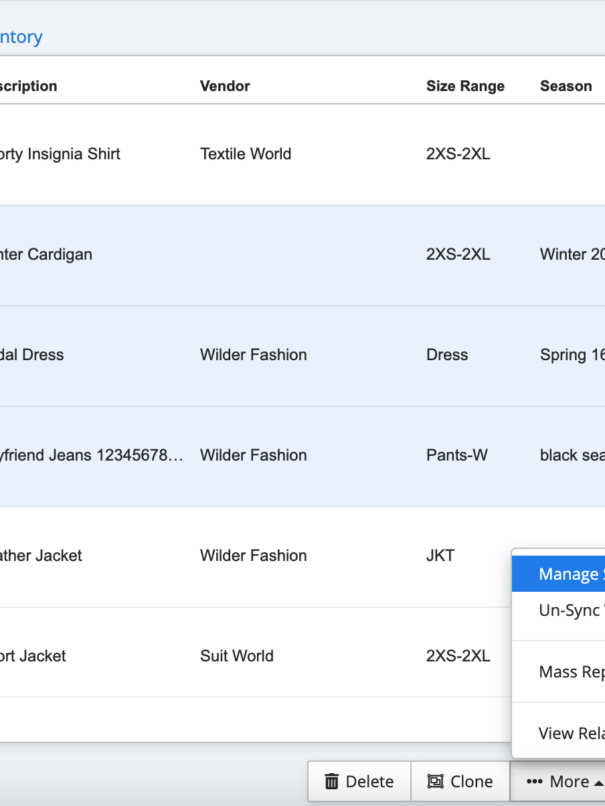Inventory management is one of the foundational elements of successful retail store management. As a component of supply chain management, the goal of inventory management is to supervise the flow of products from manufacturers to warehouses and finally to point of sale.
Poor inventory management causes inefficiencies because you don’t have reliable real-time information on how much inventory you have. This raises the possibility of ordering merchandise from suppliers incorrectly or selling phantom inventory.
Proper inventory management techniques, on the other hand, can help both physical stores and online merchants see an increase in sales, cut expenses, and keep customers happy. But without the proper strategies and tools, managing your inventory can take up a lot of your time and possibly cost you money.
Not sure where to begin with inventory management? This post explains the different types of inventory, how to manage inventory in retail stores, the importance of retail store management, and more.

Photo by Alexander Kovacs on Unsplash
Types of Inventory
Inventory management is essential to a company’s daily operations because it frequently serves as a major source of income. These are only a few of the several inventory types available.
- Raw materials, i.e. materials that are used in the production of your goods
- Unfinished goods, or goods that are still in progress and not ready to be sold
- Finished products are items that are normally kept in a warehouse until they are shipped or sold
- Cycle inventory, or goods that are delivered to a business from a manufacturer or supplier, then sold to customers right away
- In-transit products are those that have left the warehouse and are being transported to their final destination
- MRO products stand for “maintenance, repair, and operation supplies” and support the production process
- Decoupling inventory, which are components, materials, or goods saved in case of a slowdown or a stop in production
- Anticipation inventory, or excess stock levels produced or stored before an anticipated spike in sales
- Excess inventory, often referred to as obsolete inventory, are unused or unsold raw materials or products that a business must pay to store even though it doesn’t anticipate selling or using them.
- Safety stock, also known as buffer inventory, acts as a backup in case an unanticipated problem arises or additional inventory is required.
8 Tips on How to Manage Inventory in Retail Store
Despite the fact that inventory can be categorized and characterized in a variety of ways, it is ultimately inventory retail management that has a direct impact on an organization’s ability to fulfill orders.
There are several types of inventory management systems that businesses use. Manual inventory, periodic inventory, and perpetual inventory are three examples. Perpetual systems are the most advanced and exact, whereas manual methods are the least advanced and accurate.
Here are the 8 inventory management tips that will contribute to better retail store management and help business owners improve cash flow.
1. Keep track of all product information
Track the product information in real-time for each inventory item, including stock keeping units (SKUs), suppliers, barcode data, lot numbers, and countries of origin. Consider tracking each item’s price over time so you can be aware of elements like seasonality and scarcity that might affect the price.
You can also track your inventory turnover rate, i.e. the number of times your business’s inventory is sold throughout a predefined period of time (a month, quarter, or a year). The inventory turnover ratio formula divides the cost of all products sold by the average inventory for the same time period.
2. Do Regular Counts of Inventory
Efficient counts of inventory are the best way to ensure accurate inventory. To ensure accurate stock counts and prevent mistakes, take damage, shrinkage, and returns into consideration. This process can be simplified by retail inventory management software because you don’t have to start from scratch; you just need to double-check your data.
The complexity, size, and type of inventory management system you employ all influence how frequently physical inventory counts are performed in your company. But at the very least, experts advise counting inventories once or twice a year. There are several counting methods you could use, including cycle counts and physical counts.
3. Deal with bad supplier issues
If your supplier is unreliable, you’ll face many inventory problems. So, if you have a bad supplier who consistently makes deliveries late or consistently under-delivers an order, be sure to take action. Conduct a supplier audit and learn what the problem is by talking about it with your supplier. Be ready to resolve issues with suppliers or even change suppliers if need be, or you will have to deal with erratic supply levels and insufficient inventory as a result.
4. Track your sales
Tracking your sales involves much more than simply adding up product purchases at the end of each day. You should regularly update your inventory and be aware of what and how many things you sold. In addition, you will need to analyze this data. When do specific things start to sell more slowly or less? Are there particular things that you sell on a given day of the week? Do some products frequently sell in groups? Maintaining control over your retail inventory requires understanding your sales patterns and figures but also the bigger picture of how things sell.
5. Create a stock receiving process
During the stock receiving process, you will check incoming orders and accurately input the commodities into an effective inventory management system. Verify the contents of each delivery against the purchase order to ensure they are in accordance. Count cartons and pallets, check the types and quantities of the products while noting any errors, damage, or shortages, and follow up with vendors on any issues. After that, add the additional items to inventory counts and store the merchandise. You might put price tags or bar codes on the merchandise, depending on your requirements. The simplest method of controlling inventory is perpetual inventory management, which entails counting products as soon as they arrive.
6. Create a deadstock process
Overstocking inventory drains capital and reduces profitability. Dead inventory comprises faulty deliveries, damaged goods, and unsold seasonal goods. Items that fit this category should be noted and then taken out of inventory. Establish a location for dead stock storage and handle it on a regular basis (weekly, monthly, or as needed for your company). Send pullbacks, or goods you can return to suppliers for credit, as soon as possible. You can take care of the leftovers by selling to outlets, giving, recycling, or disposing of them, depending on your product line.
7. Create a returns procedure
Without a system in place to handle customer returns, you run a higher risk of holding onto unsold inventory or skipping the chance to put a sellable item back on display. When a consumer returns an item, examine it to see if it is broken or defective and then send it back to the vendor, fix it, or write it off. Finally, be sure to re-enter usable inventory in your inventory counts and place it in your store.
8. Invest in powerful inventory management software
If your company is small, managing your inventory with spreadsheets or paper logs is doable in the beginning. However, as your retail business grows, you’ll have to spend more time managing inventory, which increases the possibility of human error and increases the risk of having your stock out of control. All of these chores are made simpler by an effective inventory management tool. Ensure that you know what you need, that a software solution offers the metrics that are crucial to your company, and that it is simple to use before making your choice.
Benefits of Managing Your Inventory in Retail
Besides “How to manage inventory in a retail store”, another important question is “Why is managing your inventory important?”
One of the most important benefits of effective retail inventory management techniques is that they enable you to forecast customer demands. Inventory forecasting is crucial in inventory control. Businesses that don’t predict customer demands and impulsively order fresh inventory can end up with product shortages or surpluses. When you have extra inventory, your capital becomes constrained by inventory. When, on the other hand, you don’t have enough of a product that’s in high demand, you’re effectively driving clients to your competition.
Retailers can get information and insights about past sales using retail management software, and this information helps them forecast how much stock they’ll need at any particular time. Thanks to stock alerts and stock notifications, you will know when there has been a significant change in your inventory levels. Reports on weekly and monthly sales figures assist businesses in purchasing inventory when necessary and help them identify slow-selling items, as well as profitable products and fast-moving items.
A successful inventory management process also results in better cash flow. Businesses can save money in many different ways, such as by reducing the chance of human error, lowering the cost of inventory storage, decreasing the likelihood of carrying slow-moving products, phantom inventory, and dead stock, improving demand forecasting, and making more informed decisions.
Finally, proper inventory management contributes to improved customer satisfaction. In addition to assisting you in giving customers what they want, when they want it, stock management also helps lower the likelihood of picking and shipping errors, as well as the likelihood that customers will receive damaged goods. All this helps build strong relationships and keep your customers happy.
Retailers can use inventory tracking to keep track of the stock-keeping units (SKUs) they have on hand, as well as their location and number. Additionally, it enables shops to keep track of and identify defective or broken goods so that they are not resold to unaware customers.

Photo by Alexander Kovacs on Unsplash
Warehouse Management vs. Inventory Management
Despite the fact that both inventory management and warehouse management are crucial for keeping track of and managing stock, they differ in a number of ways.
Inventory management is the process of monitoring and controlling the inventory levels in all warehouses, distribution centers, fulfillment centers, retail locations (including the sales floor), and other business storage facilities. It is regarded as the initial action before putting warehouse management into practice.
Warehouse management is a part of inventory management that operates at a more focused level and deals with tracking inventory inside a warehouse or storage facility.
The inventory management system (IMS) keeps track of the inventory present in all warehouses and storage facilities as well as the details of which warehouses house which products. On the other hand, a warehouse management system (WMS) keeps track of the inventory and its placement within a storage space or warehouse. Systems for managing warehouses and inventories are frequently used in conjunction to improve inventory management.
The Bottom Line
There you have it. If you have been wondering how to manage inventory in a retail store, we hope this article gives you a comprehensive answer and actionable tips that will help you create an effective inventory management plan.
Keep in mind that having a good retail inventory management system in place can help you save money, improve customer experience and customer satisfaction, maintain your company’s profitability, examine past sales data to forecast customer demands and future sales, reduce inventory costs, and help you prepare for the unexpected.
Stop losing money by taking charge of your stock management. Combine effective inventory management strategies with the appropriate retail inventory management software like ApparelMagic, which powers enterprise resource planning (ERP), product lifecycle management (PLM), customer relationship management (CRM), and fashion inventory management for some of the biggest apparel brands. The best retail inventory management software will not only help power your retail store location but will also help you to successfully manage your inventory.







